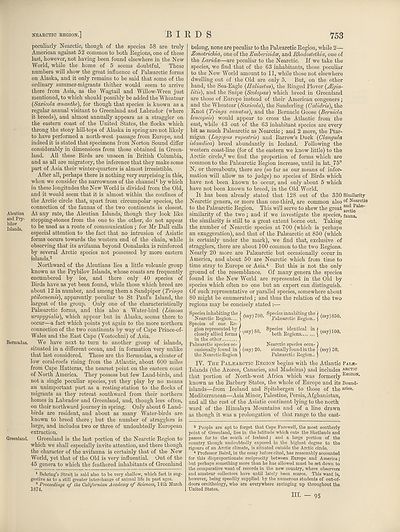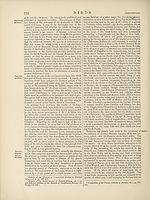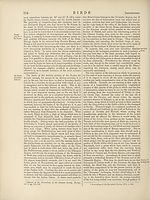Encyclopaedia Britannica > Volume 3, Athens-BOI
(765) Page 753
Download files
Complete book:
Individual page:
Thumbnail gallery: Grid view | List view

Aleutian
and Pry-
bilov
Islands.
Bermudas.
Greenland.
NEARCTIC REGION.]
BIRDS
753
peculiarly Nearctic. though, of the species 58 are truly
American against 52 common to both Regions, one of these
last, however, not having been found elsewhere in the New
World, while the home of 5 seems doubtful. These
numbers will show the great influence of Palmarctic forms
on Alaska, and it only remains to be said that some of the
ordinary summer-migrants thither would seem to arrive
there from Asia, as the Wagtail and Willow-Wren just
mentioned, to which should possibly be added the Wheatear
(Saxicola cenantke), for though that species is known as a
regular annual visitant to Greenland and Labrador (where
it breeds), and almost annually appears as a straggler on
the eastern coast of the United States, the flocks which
throng the stony hill-tops of Alaska in spring are not likely
to have performed a north-west passage from Europe, and
indeed it is stated that specimens from Norton Sound differ
considerably in dimensions from those obtained in Green¬
land. All these Birds are unseen in British Columbia,
and as all are migratory, the inference that they make some
part of Asia their winter-quarters is almost irresistible.
After all, perhaps there is nothing very surprising in this,
when we consider the narrowness of the channel1 by which
in these longitudes the New World is divided from the Old,
and it would seem that it is almost within the confines of
the Arctic circle that, apart from circumpolar species, the
connection of the faunas of the two continents is closest.
At any rate, the Aleutian Islands, though they look like
stepping-stones from the one to the other, do not appeal
to be used as a route of communication; for Mr Dali calls
especial attention to the fact that no intrusion of Asiatic
forms occurs towards the western end of the chain, while
observing that its avifauna beyond Oonalaska is reinforced
by several Arctic species not possessed by more eastern
islands.2
Northward of the Aleutians lies a little volcanic group
known as the Prybilov Islands, whose coasts are frequently
encumbered by ice, and there only 40 species of
Birds have as yet been found, while those which breed are
about 12 in number, and among them a Sandpiper (Tringa
ptilocnemis), apparently peculiar to St Paul’s Island, the
largest of the group. Only one of the characteristically
Palsearctic forms, and this also a Water-bird (Limosa
uropygialis), which appear but in Alaska, seems there to
occur—a fact which points yet again to the more northern
connection of the two continents by way of Cape Prince-of-
Wales and the East Cape (Yostochni) of Asia.
We have next to turn to another group of islands,
situated in a different ocean, and in formation very unlike
that last considered. These are the Bermudas, a cluster of
low coral-reefs rising from the Atlantic, about 600 miles
from Cape Hatteras, the nearest point on the eastern coast
of North America. They possess but few Land-birds, and
not a single peculiar species, yet they play by no means
an unimportant part as a resting-station to the flocks of
migrants as they retreat southward from their northern
homes in Labrador and Greenland, and, though less often,
on their northward journey in spring. Only about 6 Land-
birds are resident, and about as many Water-birds are
known to breed there; but the number of stragglers is
large, and includes two or three of undoubtedly European
extraction.
Greenland is the last portion of the Nearctic Region to
which we shall especially invite attention, and there though
the character of the avifauna is certainly that of the New
World, yet that of the Old is very influential. Out of the
45 genera to which the feathered inhabitants of Greenland
1 Behring’s Strait is said also to he very shallow, which fact is sug¬
gestive as to a still greater interchange of animal life in past ages.
2 Proceedings of the Californian Academy of Sciences, 14th March
1874.
belong, none are peculiar to the Pal ^arctic Region, while 2—
Zonotrichia, one of the Emberizidoe, and Rhodostethia, one of
the Laridoe—are peculiar to the Nearctic. If we take the
species, we find that of the 63 inhabitants, those peculiar
to the New World amount to 11, while those not elsewhere
dwelling out of the Old are only 5. But, on the other
hand, the Sea-Eagle (Haliaetus), the Ringed Plover (pEgia-
litis), and the Snipe (Scolopax) which breed in Greenland
are those of Europe instead of their American congeners;
and the Wheatear (/Saxicola), the Sanderling (Calidris), the
Knot (Tringa canutus), and the Bernacle Goose (Bernicla
leucopsis) would appear to cross the Atlantic from the
east, while 43 out of the 63 inhabitant species are every
bit as much Palaearctic as Nearctic; and 2 more, the Ptar¬
migan (Lagopus rupestris) and Barrow’s Duck (Clangula
islandica) breed abundantly in Iceland. Following the
western coast-line (for of the eastern we know little) to the
Arctic circle,3 we find the proportion of forms which are
common to the Palaearctic Region increase, until in lat. 750
N. or thereabouts, there are (so far as our means of infor¬
mation will allow us to judge) no species of Birds which
have not been known to occur, and only about 5 which
have not been known to breed, in the Old World.
It has been already stated that 128 out of the 330 Similarity
Nearctic genera, or more than one-third, are common also of -^earctio
to the Palaearctic Region. This will serve to shew the great arctic^*"
similarity of the two; and if we investigate the species, fauna,
the similarity is still to a great extent borne out. Taking
the number of Nearctic species at 700 (which is perhaps
an exaggeration), and that of the Palmarctic at 850 (which
is certainly under the mark), we find that, exclusive of
stragglers, there are about 100 common to the two Regions.
Nearly 20 more are Palsearctic but occasionally occur in
America, and about 50 are Nearctic which from time to
time stray to Europe or Asia.4 But this is not the only
ground of the resemblance. Of many genera the species
found in the New World are represented in the Old by
species which often no one but an expert can distinguish.
Of such representative or parallel species, somewhere about
80 might be enumerated; and thus the relation of the two
regions may be concisely stated :—
(say,700.SS“”f^«j(s,y)850.
Nearctic species occa- )
(any) 20. sionallyfoumlinthe > (say) 50.
Palsearctic Kegion.. )
IV. The Palearctic Region begins with the Atlantic Patje-
Islands (the Azores, Canaries, and Madeiras) and includes arctic
that portion of North-west Africa which was formerly Region*
known as the Barbary States, the whole of Europe and its Bound-
islands—from Iceland and Spitsbergen to those of the aries-
Mediterranean—Asia Minor, Palestine, Persia, Afghanistan,
and all the rest of the Asiatic continent lying to the north
ward of the Himalaya Mountains and of a line drawn
as though it was a prolongation of that range to the east-
bpecies inhabiting the j
Nearctic Region.... (
Species of one Re- j
gion represented by r
closely allied forms (
in the other )
Palsearctic species oc- 1
casionalljT found in >
the Nearctic Region )
3 People are apt to forget that Cape Farewell, the most southerly
point of Greenland, lies in the latitude which cuts the Shetlands and
passes far to the south of Iceland ; and a large portion of the
country though undoubtedly exposed in the highest degree to the
rigours of an Arctic climate, is situated outside the Arctic circle.
4 Professor Baird, in the essay before cited, has reasonably accounted
for this disproportionate reciprocity between Europe and America;
but perhaps something more than he has allowed must be set down to
the comparative want of records in the new country, where observers
and amateur collectors have until lately been scarce. This want is,
however, being speedily supplied by the numerous students of out-of-
doors ornithology, who are everywhere springing up throughout the
United States.
III. - 95
and Pry-
bilov
Islands.
Bermudas.
Greenland.
NEARCTIC REGION.]
BIRDS
753
peculiarly Nearctic. though, of the species 58 are truly
American against 52 common to both Regions, one of these
last, however, not having been found elsewhere in the New
World, while the home of 5 seems doubtful. These
numbers will show the great influence of Palmarctic forms
on Alaska, and it only remains to be said that some of the
ordinary summer-migrants thither would seem to arrive
there from Asia, as the Wagtail and Willow-Wren just
mentioned, to which should possibly be added the Wheatear
(Saxicola cenantke), for though that species is known as a
regular annual visitant to Greenland and Labrador (where
it breeds), and almost annually appears as a straggler on
the eastern coast of the United States, the flocks which
throng the stony hill-tops of Alaska in spring are not likely
to have performed a north-west passage from Europe, and
indeed it is stated that specimens from Norton Sound differ
considerably in dimensions from those obtained in Green¬
land. All these Birds are unseen in British Columbia,
and as all are migratory, the inference that they make some
part of Asia their winter-quarters is almost irresistible.
After all, perhaps there is nothing very surprising in this,
when we consider the narrowness of the channel1 by which
in these longitudes the New World is divided from the Old,
and it would seem that it is almost within the confines of
the Arctic circle that, apart from circumpolar species, the
connection of the faunas of the two continents is closest.
At any rate, the Aleutian Islands, though they look like
stepping-stones from the one to the other, do not appeal
to be used as a route of communication; for Mr Dali calls
especial attention to the fact that no intrusion of Asiatic
forms occurs towards the western end of the chain, while
observing that its avifauna beyond Oonalaska is reinforced
by several Arctic species not possessed by more eastern
islands.2
Northward of the Aleutians lies a little volcanic group
known as the Prybilov Islands, whose coasts are frequently
encumbered by ice, and there only 40 species of
Birds have as yet been found, while those which breed are
about 12 in number, and among them a Sandpiper (Tringa
ptilocnemis), apparently peculiar to St Paul’s Island, the
largest of the group. Only one of the characteristically
Palsearctic forms, and this also a Water-bird (Limosa
uropygialis), which appear but in Alaska, seems there to
occur—a fact which points yet again to the more northern
connection of the two continents by way of Cape Prince-of-
Wales and the East Cape (Yostochni) of Asia.
We have next to turn to another group of islands,
situated in a different ocean, and in formation very unlike
that last considered. These are the Bermudas, a cluster of
low coral-reefs rising from the Atlantic, about 600 miles
from Cape Hatteras, the nearest point on the eastern coast
of North America. They possess but few Land-birds, and
not a single peculiar species, yet they play by no means
an unimportant part as a resting-station to the flocks of
migrants as they retreat southward from their northern
homes in Labrador and Greenland, and, though less often,
on their northward journey in spring. Only about 6 Land-
birds are resident, and about as many Water-birds are
known to breed there; but the number of stragglers is
large, and includes two or three of undoubtedly European
extraction.
Greenland is the last portion of the Nearctic Region to
which we shall especially invite attention, and there though
the character of the avifauna is certainly that of the New
World, yet that of the Old is very influential. Out of the
45 genera to which the feathered inhabitants of Greenland
1 Behring’s Strait is said also to he very shallow, which fact is sug¬
gestive as to a still greater interchange of animal life in past ages.
2 Proceedings of the Californian Academy of Sciences, 14th March
1874.
belong, none are peculiar to the Pal ^arctic Region, while 2—
Zonotrichia, one of the Emberizidoe, and Rhodostethia, one of
the Laridoe—are peculiar to the Nearctic. If we take the
species, we find that of the 63 inhabitants, those peculiar
to the New World amount to 11, while those not elsewhere
dwelling out of the Old are only 5. But, on the other
hand, the Sea-Eagle (Haliaetus), the Ringed Plover (pEgia-
litis), and the Snipe (Scolopax) which breed in Greenland
are those of Europe instead of their American congeners;
and the Wheatear (/Saxicola), the Sanderling (Calidris), the
Knot (Tringa canutus), and the Bernacle Goose (Bernicla
leucopsis) would appear to cross the Atlantic from the
east, while 43 out of the 63 inhabitant species are every
bit as much Palaearctic as Nearctic; and 2 more, the Ptar¬
migan (Lagopus rupestris) and Barrow’s Duck (Clangula
islandica) breed abundantly in Iceland. Following the
western coast-line (for of the eastern we know little) to the
Arctic circle,3 we find the proportion of forms which are
common to the Palaearctic Region increase, until in lat. 750
N. or thereabouts, there are (so far as our means of infor¬
mation will allow us to judge) no species of Birds which
have not been known to occur, and only about 5 which
have not been known to breed, in the Old World.
It has been already stated that 128 out of the 330 Similarity
Nearctic genera, or more than one-third, are common also of -^earctio
to the Palaearctic Region. This will serve to shew the great arctic^*"
similarity of the two; and if we investigate the species, fauna,
the similarity is still to a great extent borne out. Taking
the number of Nearctic species at 700 (which is perhaps
an exaggeration), and that of the Palmarctic at 850 (which
is certainly under the mark), we find that, exclusive of
stragglers, there are about 100 common to the two Regions.
Nearly 20 more are Palsearctic but occasionally occur in
America, and about 50 are Nearctic which from time to
time stray to Europe or Asia.4 But this is not the only
ground of the resemblance. Of many genera the species
found in the New World are represented in the Old by
species which often no one but an expert can distinguish.
Of such representative or parallel species, somewhere about
80 might be enumerated; and thus the relation of the two
regions may be concisely stated :—
(say,700.SS“”f^«j(s,y)850.
Nearctic species occa- )
(any) 20. sionallyfoumlinthe > (say) 50.
Palsearctic Kegion.. )
IV. The Palearctic Region begins with the Atlantic Patje-
Islands (the Azores, Canaries, and Madeiras) and includes arctic
that portion of North-west Africa which was formerly Region*
known as the Barbary States, the whole of Europe and its Bound-
islands—from Iceland and Spitsbergen to those of the aries-
Mediterranean—Asia Minor, Palestine, Persia, Afghanistan,
and all the rest of the Asiatic continent lying to the north
ward of the Himalaya Mountains and of a line drawn
as though it was a prolongation of that range to the east-
bpecies inhabiting the j
Nearctic Region.... (
Species of one Re- j
gion represented by r
closely allied forms (
in the other )
Palsearctic species oc- 1
casionalljT found in >
the Nearctic Region )
3 People are apt to forget that Cape Farewell, the most southerly
point of Greenland, lies in the latitude which cuts the Shetlands and
passes far to the south of Iceland ; and a large portion of the
country though undoubtedly exposed in the highest degree to the
rigours of an Arctic climate, is situated outside the Arctic circle.
4 Professor Baird, in the essay before cited, has reasonably accounted
for this disproportionate reciprocity between Europe and America;
but perhaps something more than he has allowed must be set down to
the comparative want of records in the new country, where observers
and amateur collectors have until lately been scarce. This want is,
however, being speedily supplied by the numerous students of out-of-
doors ornithology, who are everywhere springing up throughout the
United States.
III. - 95
Set display mode to:
![]() Universal Viewer |
Universal Viewer | ![]() Mirador |
Large image | Transcription
Mirador |
Large image | Transcription
Images and transcriptions on this page, including medium image downloads, may be used under the Creative Commons Attribution 4.0 International Licence unless otherwise stated. ![]()
| Encyclopaedia Britannica > Encyclopaedia Britannica > Volume 3, Athens-BOI > (765) Page 753 |
|---|
| Permanent URL | https://digital.nls.uk/193660246 |
|---|
| Attribution and copyright: |
|
|---|---|
| Shelfmark | EB.17 |
|---|---|
| Description | Ten editions of 'Encyclopaedia Britannica', issued from 1768-1903, in 231 volumes. Originally issued in 100 weekly parts (3 volumes) between 1768 and 1771 by publishers: Colin Macfarquhar and Andrew Bell (Edinburgh); editor: William Smellie: engraver: Andrew Bell. Expanded editions in the 19th century featured more volumes and contributions from leading experts in their fields. Managed and published in Edinburgh up to the 9th edition (25 volumes, from 1875-1889); the 10th edition (1902-1903) re-issued the 9th edition, with 11 supplementary volumes. |
|---|---|
| Additional NLS resources: |
|

